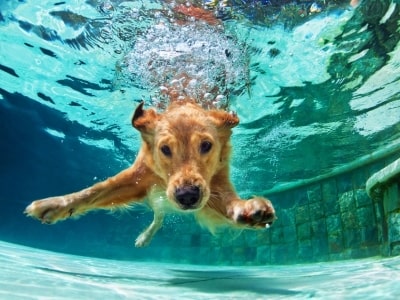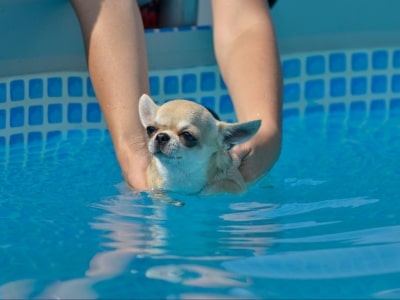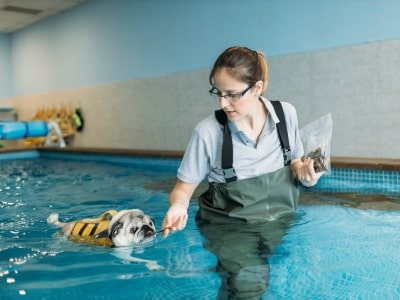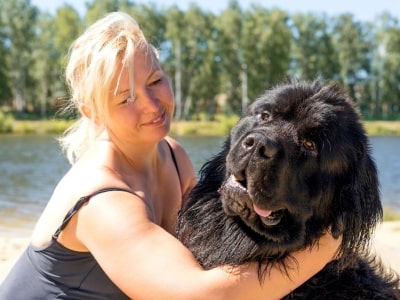It is a little weird to imagine a dog swimming with its four legs. But can dogs swim? Let me tell you one Fun Fact about dogs, their bodies are built to swim. Most dogs already know how to swim. Those who do not know how to swim can learn to swim way faster than humans.
Dogs can swim in only one style, which is the dog paddle or doggy paddle style. They keep their head up while swimming and they are not splashy at it. So they look very cute when they swim. If your dog doesn’t know how to swim then, initially splash a bit but then they slowly get used to it and get less splashy.
Let’s discuss which breed can and cannot swim, and also how to teach swimming to your dog.
Swimming Ability of Different Dog Breeds
Many people have misconceptions that all dogs have natural instincts of swimming. But the reality is all dogs can not swim. Basically, there are three types of dogs. Firstly, those who have natural instincts and they can easily swim. Then comes those breed of dogs who can swim but required little help. And lastly, some dogs are like a rock in the water. Let’s check it out in detail.
Dogs Who Can Naturally Swim Well
Some dog breeds are born swimmers. These breeds of dogs are also used for rescue activities. They not only swim but they enjoy swimming. There are some exceptions in which dogs who are born swimmers but have disabilities or injuries can not.
According to PetMd “There are certain breeds that are often more adept at swimming. These dogs have generations of ancestors in their blood that were bred to retrieve from water”

Let me share with you the lists of swimmer dog breeds. Which include Retrievers and Spaniels, such as the Labrador Retriever, Golden Retriever, American Water Spaniel, Irish Water Spaniel, and Portuguese Water Dog.
These dogs have strong, long, hind legs, which help them to swim easily. Their legs work like peddles, so it is called “doggy paddle,” swimming style.
If you have a dog from any of these breeds but have not seen him swimming, then you should not just assume that he will swim effortlessly. You should take care of a few things like, never allowing him to go in deep water directly, and standing beside him like a supervisor, observing him initially whether he can swim or not then you can allow him to swim anywhere.
Additionally, I know these breeds are very good at swimming but even they can pull out by currents, suffer injuries, or fall off boats, and for any reason, they can drown in water. So it is better to have a doggy life jacket.
Dogs Who Need Help Swimming
Dogs might have natural instincts for swimming but not all dogs can swim like they are born swimmers. Mostly, small and medium breeds of dogs need help while swimming, such as Chihuahuas and the Maltese.
They can swim but they do not like to swim as they may have “Small Dog Syndrome” which means they think they are too small to swim and they get scared by swimming.

They also get panic sometimes and so even though they are swimming, they will try to get out anyhow. If you have the same type of dog then I have some suggestions for you.
If your dog is capable to swim but not able to swim because of any reason, then you should gradually introduce him to water. First, start with a bathtub or shallow water. When you see, he starts enjoying swimming there, then you should slowly take him to deep water.
To make him love water, you can apply a reward system where you can give a treat if he successfully swims without panicking. Also, you can let your dog swim with other dogs who already are swimmers. This will encourage him to swim.
Make sure you do not push your dog’s limits. It will make him hate water more.
Dogs Who Aren’t Natural Swimmers
Some breeds are just not made for the water. They sink like rocks in the water. This is because of their body structure, dogs with large, boxy chests, shorter hind legs, or short muzzles are not suitable for swimming. Swimming would be a very tough task for these breeds.
You should be extra careful if you have Boxers, Pugs, Basset Hounds, and, most notoriously, the Bulldog. These breeds find it difficult to breathe while swimming because of their body structure.
I would suggest you if you have this kind of breed, then do not try hard to teach him to swim. All these breeds should be under constant surveillance.
Make sure even if your dog is a pro swimmer, you invest in some dog swimming gear to keep them safe.

Therefore, swimming ability does not depend upon the dog’s willingness, but it more depends upon their body structure which allows them to swim.
Training Your Dog to Swim
If your dog is among the swimmer dog then you do not need to worry much about teaching. But if your dog is not a swimmer and he needs your help to become a swimmer, then I have step by step process which you can follow.
Start Slowly
No dog owner wants to make their dog struggle while teaching swimming. If you do not know whether your dog knows to swim or not, do not just push him in the water directly. First, take him to the bathtub or children’s pool area. If he gets comfortable then you should slowly go deeper.
You also should check the water, it should not be too cold or too hot. Moreover, instead of just let him swim, go with him to encourage his efforts by giving rewards. It will not only encourage him, but also it will make him feel safe as you are around.
Take Frequent Breaks
You should give me frequent breaks whether he wants or not. Sometimes, in excitement and enjoyment, dogs tend to avoid breaks. But if you see your dog heavily breathing or you see him struggling to swim then you have to imminently get your dog out. Therefore, taking rest is important, the dog cannot learn to swim when he is too tired.
Rinse Off To Keep Your Dog Healthy
It is very good practice to clean your dog. If you took swimming lessons with your dog in a pool, then the chlorine in the water can damage their skin. And the water of lakes or rivers can give harmful bacteria. To avoid that rise or shampoo his fur and skin thoroughly.

Have Fun Teaching Your Dog to Swim
Mostly in the initial days of swimming, dogs do not enjoy swimming. But you will know if they are having fun in the pool. You are lucky if your dog likes to swim, but sometimes dogs are land lovers. Those dogs never enjoy swimming.
Therefore, your dog is not a fish so he must know how to swim. If he does not want to learn to swim then it is okay.
Safety Tips for Swimming with Your Dog
- Don’t assume that all dogs can swim. You have to know which breed of dog you have. It all depends upon the natural capacity of the individual dog.
- Do not be in rush to teach him swimming. Many dogs need support and encouragement to go into the water. If your dog is not born a swimmer then you should take it slow.
- Do not think that swimmer dogs never get drowned. Even if you have been born a swimmer or learner dog, you should have a doggy life jacket with you. It is more useful for those who are having a hard time learning to swim.
- Before you enter the water, make sure to teach your dog that he is not supposed to drink water. Drinking water from a pool, lack, or sea, will only make him sick. Especially, the salt water of the sea is extremely harmful to him.
- No matter wherever you take your dog swimming, you should always keep your watch on your dog. Not only during swimming but also after it if he gets ill.
- The most important thing is, you should check whether there are Blue-green algae it is also called “cyanobacteria“. It is normally found in lakes or pools. It is very dangerous for dogs and humans too.
“Sadly, exposure to toxic blue-green algae is often fatal, and can also cause long-term health problems in dogs that survive after drinking or swimming in algae-contaminated water. Some types of blue-green algae can kill a dog just 15 minutes to an hour after drinking contaminated water.” stated in BlueCross
FAQs
Is it safe to let my dog swim in a pool?
It can be safe for your dog to swim in a pool, but it’s essential to supervise them at all times and make sure they know how to leave the pool safely. Additionally, chlorine and other chemicals in the pool can be dangerous to your dog’s skin and eyes, so be sure to rinse them off after swimming.
Can all dogs swim in saltwater?
Most dogs can swim in saltwater, but it’s important to rinse them off with fresh water after to avoid skin irritation. Additionally, some dogs may be sensitive to salt and need extra precautions.
How can I teach my dog to swim?
Start by introducing your dog to shallow water and slowly encouraging them to progress further in. Use positive support and make sure they feel safe and supported at all times.
Is it safe to take my dog swimming in a river or lake?
Swimming in natural bodies of water like rivers and lakes can be safe for dogs, but it’s necessary to check for any potential dangers like powerful currents or waterborne illnesses. Additionally, make sure your dog has up-to-date vaccinations and avoid places with toxic algae blooms.
What should I do if my dog gets tired while swimming?
If your dog gets tired while swimming, help them exit the water and provide them with a safe and cozy spot to rest. Make sure to protect your dog from signs of exhaustion, like slowing down or panting heavily, and avoid overexerting them.
Conclusion
In conclusion, to answer the question can dogs swim? Yes, dogs are capable of swimming to some degree with the right training, supervision, and safety precautions. While not all dogs are natural swimmers, most can learn and enjoy swimming as a fun and healthy activity. However, it’s crucial to always watch your dog around water and take the necessary steps to ensure its safety.
Whether you’re splashing around in the pool, enjoying a day at the beach, or exploring a natural body of water, swimming can be a great way to connect with your furry friend and keep them engaged and happy. So, whether your dog is a natural swimmer or needs some extra guidance, grab a life jacket, head to the water, and enjoy making a splash with your four-legged companion.
Reference:
- Swimmer puppy syndrome. (2023, January 30). In Wikipedia. https://en.wikipedia.org/wiki/Swimmer_puppy_syndrome
- Kim, A., Na, J., Cho, K., & Shin, S. (2013). Home-care treatment of swimmer syndrome in a miniature schnauzer dog. The Canadian Veterinary Journal, 54(9), 869-872. https://www.ncbi.nlm.nih.gov/pmc/articles/PMC3743573/
- Bauhaus, J. (2020, March 10). Hydrotherapy for Dogs: A Growing Trend in Canine Physical Therapy. American Kennel Club. Retrieved March 13, 2024, from https://www.akc.org/expert-advice/health/hydrotherapy-for-dogs-growing-trend-in-canine-physical-therapy/



